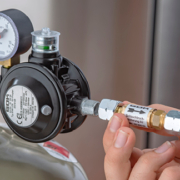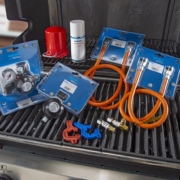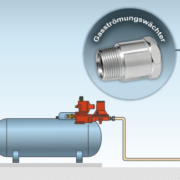How does a PRV pressure relief valve work?
The pressure relief valve is a safety device integrated into the pressure regulator. It discharges LPG into the environment as soon as the pressure exceeds the defined maximum value.
Either the PRV (Pressure Relief Valve) is the only safety device of the pressure regulator or it is combined with the OPSO (Over-Pressure Shut Off).
PRV as sole safety device
- Dirt gets stuck to a narrow part of the pressure regulator.
- The pressure rises continuously and exceeds the maximum permissible value.
- The overpressure raises the diaphragm.
- The position change of the diaphragm causes a gap to open at the valve lever.
- The overpressure escapes from the ventilation opening in the cover of the pressure regulator.
PRV combined with OPSO
- The OPSO responds to overpressure and blocks the gas flow.
- Strong sunlight or increasing temperatures will cause a pressure increase in the line and pressure regulator.
- The overpressure raises the diaphragm.
- The position change of the diaphragm causes a gap to open at the valve lever.
- The overpressure escapes from the ventilation opening in the cover of the pressure regulator.
Once the overpressure has been relieved, the PRV closes automatically, whether it is the sole safety device or combined with an OPSO.
What can you do if the PRV has discharged?
For pressure regulators with PRV as a single safety device as well as in combination with the OPSO, we recommend that you consult a specialist who checks the system.
Tip for the specialist: Take a look at our article on how to release the OPSO again.






